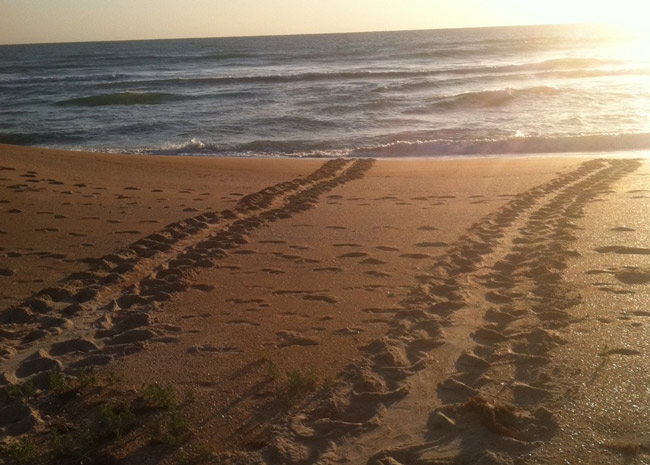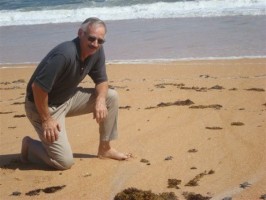
At dawn this past Tuesday morning, one of the oldest reptiles on earth began its annual high risk ritual–returning to land for a brief time to deposit eggs into a deep hole on a beach. I know this occurred last Tuesday (April 24) because I have the tracks on the beach behind my home to prove it. According to the Flagler Turtle Patrol, there had been no other tracks reported previously this year in Flagler County.
 As they have for over 200 million years, pregnant female sea turtles soon will be dragging their egg-laden heavy bodies from the comfort of the ocean onto Florida beaches. For at least 20 years, the typical age of sexual maturity, female sea turtles roam the Atlantic Ocean for thousands of miles, many of them wandering in a large clockwise rotation that bring them to places familiar to sailors and world travelers–Newfoundland, Greenland, British Isles, Azores, and the Caribbean Sea.
As they have for over 200 million years, pregnant female sea turtles soon will be dragging their egg-laden heavy bodies from the comfort of the ocean onto Florida beaches. For at least 20 years, the typical age of sexual maturity, female sea turtles roam the Atlantic Ocean for thousands of miles, many of them wandering in a large clockwise rotation that bring them to places familiar to sailors and world travelers–Newfoundland, Greenland, British Isles, Azores, and the Caribbean Sea.
Once of age to conceive, the future mothers mate and return to beaches of their birth through a navigation system not totally understood by scientists. A form of imprinting, similarly found in other species, such as whales, allows the turtles to return to their birth beach after many years and thousands of miles of ocean travel. Even new turtle hatchlings seem to have a navigational instinct that steers them to their first live food in the Sargasso seaweed some 20 or more miles offshore.
Of the seven sea turtle species in the world, five are found in Florida waters, with the most frequent visitors being loggerheads (Caretta caretta), green (Chelonia mydas), and leatherback (Dermochelys coriacea). Hawksbill (Eretmochelys imbricate) and Kemp’s ridley (Lepidochelys kempii) are rarely sighted in Florida and the other two species, flatback (Natator depressus) and olive ridley (Lepidochelys olivacea), do not travel to Florida.
When the pregnant female lumbers ashore, usually during the dark of night, she advances up the beach slope to a chosen spot, where she digs a large nesting area at least 18 inches deep. In what may take an hour, she deposits 80 to 120 eggs and laboriously covers the nest by moving sand with her flippers. Once finished, she returns to the open ocean to either continue her roaming or to respond to another internal urging to return to shore to deposit another clutch of eggs. In one season, certain females may make two or three nests as part of nature’s way of increasing the odds for survival.
At the bottom of this column is a video I took of a nesting loggerhead female on the beach behind our home in 2010. She came ashore about an hour after dawn, which was quite rare. Several vacationers arrived as I was filming and I stayed busy calling the Turtle Patrol, videotaping, answering questions, and keeping the kids from running in front of the turtle on her return to the ocean.
In roughly 50 to 60 days, the sand at the top of the nests begins to move in what is called a “boil,” a tell-tale sign of life beneath the surface. Eggs are being broken open by tiny beaks built to pierce the ping-pong ball size eggs and the hatchlings begin their scramble to the surface. Over the next day or two, hatchlings break out of their sand home to be exposed to a whole new world of sounds, smells and sights. Using their inherited instincts, they look for whatever moonlight is on the ocean and listen for waves as directional signals for where they need to go. This is their first encounter with an outside world that is full of natural and man-made challenges.
Natural predators may have taken a toll even before the eggs hatched. Fire ants, raccoons, ghost crabs, snakes, and unleashed dogs may follow their instincts or noses to the eggs, which make a nutritious meal. As hatchlings, they are a favorite target for crabs and birds on the beach and various creatures in the ocean. Scientists say there is a 1-in-5,000 chance that a female hatchling will live long enough to return to shore to make her own nest, some 20 to 30 years later.
The second video at the bottom of this column features loggerhead hatchlings emerging and heading for the water. I borrowed the video from YouTube and it did not give any credit or say where it was shot. It does, however, offer a vivid image of what an emergence looks like.

Man-made obstacles include a variety of things that many of us might never imagine. Hatchlings can be disorientated by following artificial illumination and ending up on roadways. They can then be too exhausted to make their way to the ocean. Such disorientations are recorded every year along the coast. Even seemingly innocent things like canopies, sun shades, and beach chairs left overnight present huge challenges to new animals which are three inches long and have just begun to use their muscles and survival skills.
Because the three sea turtle species found in our area are listed by the Endangered Species Act as either endangered (green and leatherback) or threatened (loggerhead), federal laws and state guidelines regulate human activity in and around beaches during nesting season from May 1st through October 31st each year.
As human stewards of nature, here is how you can help protect sea turtles on land and in the ocean:
- If beach driving is allowed (as in St. Johns and Volusia Counties) follow the regulated beach driving hours and procedures.
- Follow lighting laws in beachfront properties
- Use trash and recycling receptacles at the beach.
- Remove ruts and fill in holes left by vehicles and sand castle building.
- Do not leave chairs, umbrellas or canopies on the beach overnight.
- Flashlights, fireworks and open fires are prohibited in most counties, including St. Johns and Volusia.
- All activities are prohibited in the sand dunes and the Conservation Zone (15 feet seaward of the dune line).
- Use of balloons is discouraged, as they may fall into the ocean or onto the beach and can harm marine life, especially sea turtles.
- Do not disturb or handle any sea turtles, their eggs or nests. Endangered species are protected by county, state and federal laws with fines up to $20,000.
- Those who encounter an injured, sick or dead sea turtle should call the Florida Fish and Wildlife Conservation Commission (888/404-3922).
If you’d like to volunteer for a turtle patrol in your area, you can contact the Volusia Flagler Turtle Patrol, or do an Internet search for “turtle patrol + name of your county,” or email me and I’ll put you in touch with the appropriate group for your coastal location.
Until next time, be well and take care of nature so we can pass it on to those who follow us.
![]()
Frank Gromling is the owner of Ocean Publishing in Flagler Beach. Reach him by email here.




























B. Claire says
What a joy…perilous, indeed…but pure joy to watch Mother Nature at work.
Wish this was MY back yard!
Thank you Mr. Gromling :)
goalie says
Thank you for sharing this story. I have only lived in Florida for 3 years and I have yet to see a sea turtle. My 1 year old son loved watching the videos of the turtles and helped to let him know these are important creatures. It was beautiful thank you again.
Geezer says
It’s a breath of fresh air to read articles such as this.
I wish that human population would stabilize so that we encroach
less upon all other living creatures, who also have a right and purpose to live.
This is but one reason why I’m against offshore oil drilling.
What is a world without these wonderful creatures?
Michelle says
Ironic how the tracks of the female turtle resemble the tracks of a 4 wheeler. Does the turtle patrol ‘erase’ their 4 wheeler tracks so the hatchlings can make it to the water? I remember seeing them last year, guess that ‘obstacle’ is not an issue… like the bonfires.
Liana G says
What a co-incidental article! Just the other day, my kids and I were discussing the parenting skills of ‘good mothers’, and sea turtles and alligators came into the discussion. The conversation started over a stray cat we took in who surprised us with kittens several weeks later. We have several cats who are all fixed, so no babies from them. But ever since this kitten (we found this out from the vet) gave birth her kittens, parenting skills have become the center of conversations in our household, from being overly protective to being very selfish – when she wouldn’t let them near her kittens.
Not surprisingly, this conversation got around to how instinctive some behaviors are, and I randomly picked alligators and turtles to point out how even they too are protective when they lay theirs egg because they stay with the eggs and then take the hatchlings back to the water and stay close to them to protect them…. but before I could go any further, one of my kids vehemently pointed out that turtles were horrible parents because they just lay their eggs and abandon them. I guess I did not know that about turtles. But I’m pretty sure (from watching nature shows) that alligators do protect theirs up to young adolescence? Nature is truly Darwinian isn’t it? Aided by humans direct and indirect destruction. Thanks for another fascinating article…
I never understood why people feel the need to drive on the beach and ruin the ambiance they are obviously seeking.
John Smith says
The paths by the adult turtles will be washed away by mother nature over the months unlike the debris left by the bon fire people who refuse to pickup after themselves and it gets spread down the beach. It would be nice to have a county wide burn all summer to settle this point.